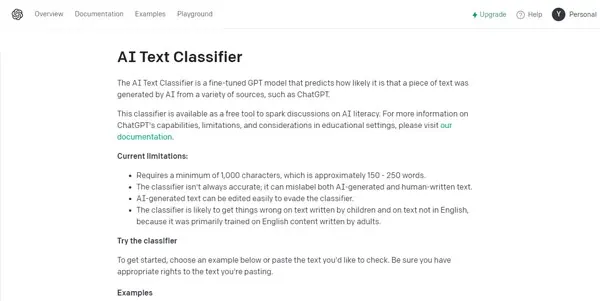AI Text Classifier

The official tool created by the company OpenAI for the detection of content written by an AI
AI Text Classifier: OpenAI's Tool for Detecting AI-Generated Content
OpenAI's AI Text Classifier is a free tool designed to identify text likely generated by AI. While not perfect, it offers a valuable resource for educators, researchers, and content creators seeking to distinguish between human-written and AI-generated text. Categorized under the broader umbrella of "RIP AI" tools, it represents a significant step in addressing the challenges posed by the proliferation of AI-generated content.
What the AI Text Classifier Does
The AI Text Classifier analyzes text input and provides a classification indicating the likelihood that it was generated by an AI. The output is presented as a probability assessment, not a definitive judgment. The tool assesses the text's characteristics, comparing them to patterns observed in a large dataset of AI-generated text. It's crucial to understand that the tool's results should be interpreted cautiously, as it's not foolproof and its accuracy varies depending on the input text's length and style.
Main Features and Benefits
- Free Accessibility: The tool is available to everyone free of charge, removing financial barriers to its use.
- Ease of Use: The classifier's user interface is straightforward, requiring minimal technical expertise. Simply paste the text into the designated field and click submit.
- Probability-Based Output: Instead of a simple "AI-generated" or "human-written" label, the classifier provides a probability score, allowing for more nuanced interpretation.
- Supports Multiple Languages: While OpenAI doesn't explicitly list supported languages, the classifier demonstrates some ability to analyze text beyond English, although accuracy may vary.
Use Cases and Applications
The AI Text Classifier finds application in various fields:
- Education: Educators can use it to assess the authenticity of student assignments, helping to deter plagiarism and promote academic integrity.
- Research: Researchers can leverage the tool to identify AI-generated content in datasets, ensuring the reliability of their analyses.
- Content Moderation: Websites and platforms can integrate the classifier to identify and flag potentially AI-generated spam or misinformation.
- Journalism: Fact-checkers can use it to help determine the source of online articles and identify potentially misleading content.
- Marketing & Advertising: Brands can use it to assess the authenticity of user-generated content, helping them to maintain brand integrity.
Comparison to Similar Tools
Several other AI detection tools exist, each with its strengths and weaknesses. Compared to these, OpenAI's classifier stands out due to its accessibility and straightforward nature. However, many commercial tools boast higher accuracy rates, potentially offering more reliable results, especially for sophisticated AI-generated content. The choice of tool depends on the specific needs and tolerance for uncertainty. No currently available tool provides perfect accuracy.
Pricing Information
OpenAI's AI Text Classifier is completely free to use. There are no subscription fees or hidden costs.
Limitations and Considerations
It is crucial to remember the limitations of the AI Text Classifier:
- Not foolproof: The tool is not 100% accurate and can produce false positives (flagging human-written text as AI-generated) and false negatives (failing to identify AI-generated text).
- Accuracy varies: The classifier's performance depends on several factors, including the length and complexity of the text, and the sophistication of the AI model used to generate it.
- Evolving technology: AI text generation techniques are constantly evolving, making it challenging for any detection tool to stay completely up-to-date.
The AI Text Classifier represents a valuable resource in the ongoing effort to address the challenges posed by AI-generated content. While not a perfect solution, its free accessibility and ease of use make it a practical tool for a wide range of applications. Users should, however, always interpret its output with caution and consider it as one piece of information among others when assessing text authenticity.